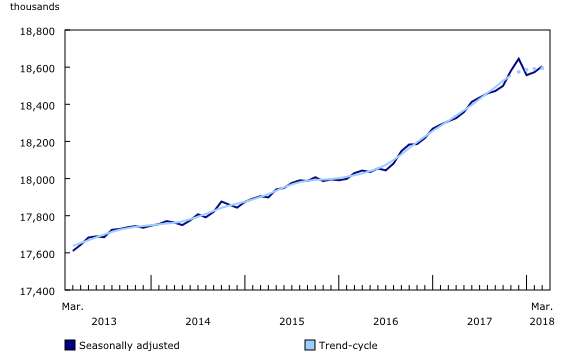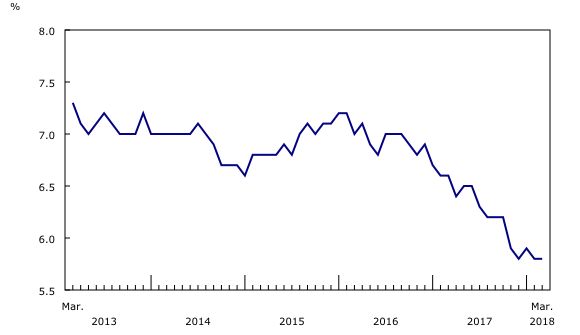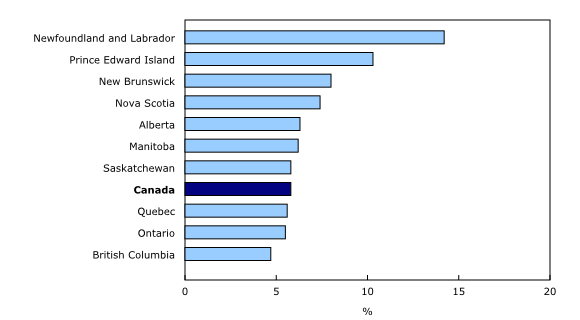Labour Force Survey, March 2018
Archived Content
Information identified as archived is provided for reference, research or recordkeeping purposes. It is not subject to the Government of Canada Web Standards and has not been altered or updated since it was archived. Please "contact us" to request a format other than those available.
Released: 2018-04-06
Employment increased by 32,000 in March, driven by full-time gains. The unemployment rate was unchanged at 5.8%.
In the first quarter of 2018, employment edged down (-40,000 or -0.2%), as a result of a decrease in January. Over the longer term, employment has been on an upward trend since the second half of 2016.
On a year-over-year basis, total employment rose by 296,000 (+1.6%), with the number of full-time workers increasing by 335,000 (+2.3%). Over the same period, total hours worked grew by 2.2%.
Highlights
In March, among the core-aged population (25 to 54 years old), employment increased for women and decreased for men. At the same time, employment was up for youth aged 15 to 24, and was little changed for people 55 years and older.
Employment was up in Quebec and Saskatchewan, while there was little change in the other provinces.
There were more people working in construction, public administration and agriculture.
The number of public sector employees edged up, while the number of private sector employees and self-employed held steady.
Demographic overview
For core-aged women, employment increased by 26,000 in March, while their unemployment rate declined 0.2 percentage points to 4.7%. On a year-over-year basis, employment for women in this age group rose by 31,000 (+0.5%).
Among men in the core age group, employment fell by 22,000. Their unemployment rate was unchanged at 4.9% as fewer of them participated in the labour market. On a year-over-year basis, employment for core-aged men increased by 50,000 (+0.8%).
Employment for youth aged 15 to 24 rose by 18,000 in March. Compared with 12 months earlier, employment for this group increased by 34,000 (+1.4%), while their unemployment rate fell by 1.6 percentage points to 10.9%.
For people 55 and older, employment was little changed and their unemployment rate increased 0.2 percentage points to 5.3%. On a year-over-year basis, employment for this group grew by 180,000 or 4.7%, outpacing their population growth rate of 2.9%.
Provincial summary
In Quebec, employment rose by 16,000 in March, and the unemployment rate was unchanged at 5.6%. Compared with 12 months earlier, employment grew by 85,000 (+2.0%). Over the same period, full-time employment trended up, rising by 150,000 or 4.5%.
In Saskatchewan, employment rose by 4,200 in March, and the unemployment rate was little changed at 5.8%. On a year-over-year basis, employment for the province was virtually unchanged. Employment in Saskatchewan has been relatively flat since the spring of 2016.
Employment in Alberta was little changed in March. On a year-over-year basis, employment rose by 41,000 (+1.8%), and the unemployment rate declined 2.0 percentage points to 6.3%. The unemployment rate in Alberta has been on a strong downward trend since its peak of 9.0% in the fall of 2016.
Employment in British Columbia held steady in March, and has been relatively unchanged since the summer of 2017. On a year-over-year basis, employment grew by 33,000 or 1.3%, lower than the average year-over-year growth rate of 3.7% throughout 2017. British Columbia continued to have the lowest unemployment rate among the provinces at 4.7% in March.
In Ontario, employment was virtually unchanged in March and the unemployment rate remained at 5.5%. Compared with 12 months earlier, employment in the province grew by 130,000 (+1.8%), mostly in full-time work (+118,000 or +2.0%).
Industry perspective
Employment in construction increased by 18,000 in March. Compared with 12 months earlier, employment in this industry grew by 54,000 (+3.8%), mostly driven by gains in the second half of 2017.
There were 12,000 more people working in public administration in March. On a year-over-year basis, employment was virtually unchanged.
In agriculture, employment rose by 8,100 in March. On a year-over-year basis, employment was flat.
On a year-over-year basis, the fastest pace of employment growth was in transportation and warehousing (+6.1% or +56,000).
The number of employees edged up in the public sector in March, while it was little changed in the private sector. On a year-over-year basis, the number of employees increased in both the public (+123,000 or +3.3%) and private (+77,000 or +0.6%) sectors.
Self-employment was little changed in March. Compared with 12 months earlier, the number of self-employed workers increased by 97,000 (+3.5%).
Quarterly update for the territories
In the first quarter of 2018, employment in Nunavut fell by 700 compared with the fourth quarter of 2017, and the unemployment rate was relatively unchanged at 12.6%.
Employment in Yukon was virtually unchanged in the first quarter of 2018, and the unemployment rate was 2.7%.
In the Northwest Territories, employment held steady and the unemployment rate increased 1.7 percentage points to 8.8%.
Sustainable Development Goals
On January 1, 2016, the world officially began implementation of the 2030 Agenda for Sustainable Development—the United Nations' transformative plan of action that addresses urgent global challenges over the next 15 years. The plan is based on 17 specific sustainable development goals.
The Labour Force Survey is an example of how Statistics Canada supports the reporting on the Global Goals for Sustainable Development. This release will be used in helping to measure the following goals:


Note to readers
The Labour Force Survey (LFS) estimates for March are for the week of March 11 to 17.
The LFS estimates are based on a sample and are therefore subject to sampling variability. As a result, monthly estimates will show more variability than trends observed over longer time periods. For more information, see "Interpreting Monthly Changes in Employment from the Labour Force Survey." Estimates for smaller geographic areas or industries also have more variability. For an explanation of the sampling variability of estimates and how to use standard errors to assess this variability, consult the "Data quality" section of the publication Labour Force Information (71-001-X).
This analysis focuses on differences between estimates that are statistically significant at the 68% confidence level.
The LFS estimates are the first in a series of labour market indicators released by Statistics Canada, which includes indicators from programs such as the Survey of Employment, Payrolls and Hours (SEPH), Employment Insurance Statistics, and the Job Vacancy and Wage Survey. For more information on the conceptual differences between employment measures from the LFS and SEPH, refer to section 8 of the Guide to the Labour Force Survey (71-543-G).
The employment rate is the number of employed people as a percentage of the population aged 15 and older. The rate for a particular group (for example, youths aged 15 to 24) is the number employed in that group as a percentage of the population for that group.
The unemployment rate is the number of unemployed people as a percentage of the labour force (employed and unemployed).
The participation rate is the number of employed and unemployed people as a percentage of the population.
Full-time employment consists of persons who usually work 30 hours or more per week at their main or only job.
Part-time employment consists of persons who usually work less than 30 hours per week at their main or only job.
In general, month-to-month or year-to-year changes in the number of people employed in an age group reflect the net effect of two factors: (1) the number of people who changed employment status between reference periods; and (2) the number of employed people who entered or left the age group (including through aging, death or migration) between reference periods.
Seasonal adjustment
Unless otherwise stated, this release presents seasonally adjusted estimates, which facilitate comparisons by removing the effects of seasonal variations. For more information on seasonal adjustment, see Seasonally adjusted data – Frequently asked questions.
Chart 1 shows trend-cycle data on employment. These data represent a smoothed version of the seasonally adjusted time series, which provides information on longer-term movements, including changes in direction underlying the series. These data are available in CANSIM table 282-0087 for the national level employment series. For more information, see the StatCan Blog and Trend-cycle estimates – Frequently asked questions.
Next release
The next release of the LFS will be on May 11.
Products
A more detailed summary, Labour Force Information (71-001-X), is now available for the week ending March 17.
More information about the concepts and use of the Labour Force Survey is available online in the Guide to the Labour Force Survey (71-543-G).
The updated Labour Market Indicators dashboard (71-607-X2017001) is available. This interactive dashboard provides easy, customizable access to key labour market indicators. Users can now configure an interactive map and chart showing labour force characteristics at the national, provincial or census metropolitan area level.
The product Labour Market Indicators, by province, territory and economic region, unadjusted for seasonality (71-607-X2017002) is also available. This dynamic web application provides access to Statistics Canada's labour market indicators for Canada, by province, territory and economic region, and allows users to view a snapshot of key labour market indicators, observe geographical rankings for each indicator using an interactive map and table, and easily copy data into other programs.
Contact information
For more information, contact us (toll-free: 1-800-263-1136; 514-283-8300; STATCAN.infostats-infostats.STATCAN@canada.ca).
To enquire about the concepts, methods or data quality of this release, contact Andrew Fields (613-951-3551; andrew.fields@canada.ca), Vincent Ferrao (613-951-4750; vincent.ferrao@canada.ca), or Client Services (toll-free: 1-866-873-8788; statcan.labour-travail.statcan@canada.ca), Labour Statistics Division.
- Date modified:






